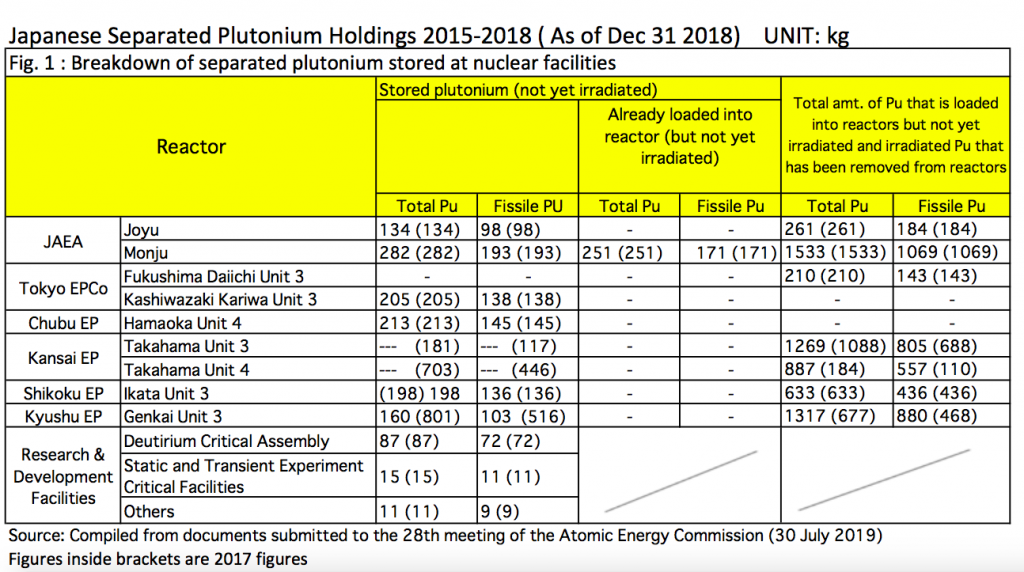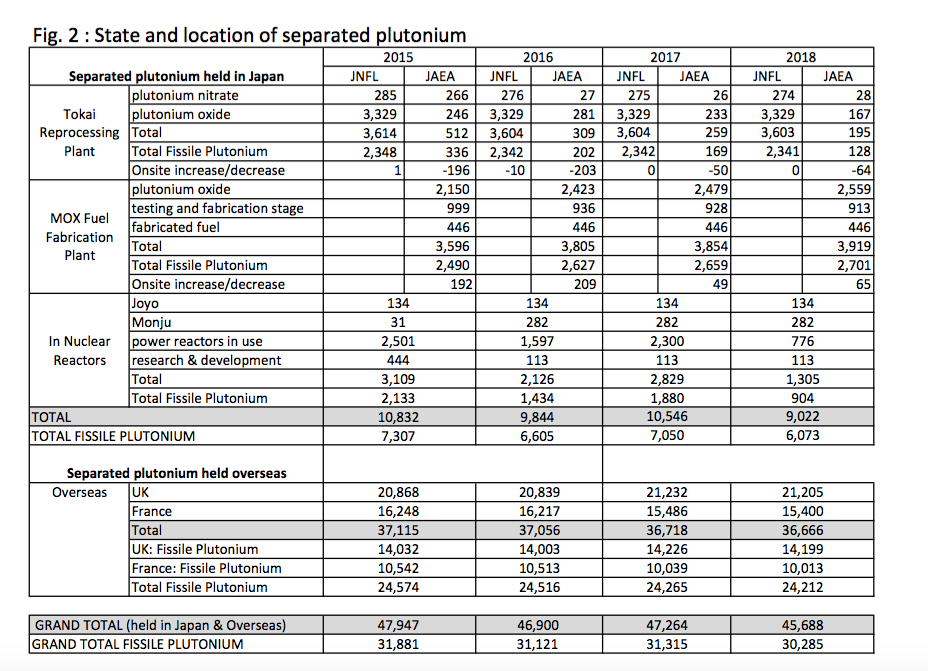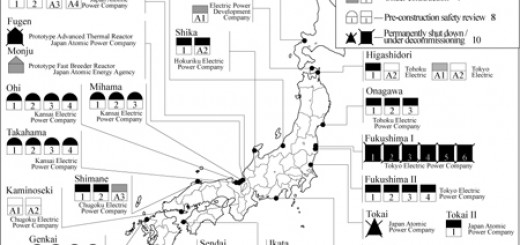Japan’s Plutonium Stockpile Data for 2018
by Ban Hideyuki (CNIC Co Director)
The 2018 official report on Japan’s stockpile of extracted plutonium revealed that the amount of such plutonium stored at the Japan Nuclear Fuel Ltd. (JNFL) Rokkasho Reprocessing Plant showed no changes, while the plutonium stored at the Japan Atomic Energy Agency (JAEA) Tokai Reprocessing Plant declined after plutonium oxide was delivered to the fuel processing facility.
Naturally, the amount of plutonium oxide stored in the fuel processing facility increased, but no fuel processing has been conducted there to date. Since it has already been decided to shut down the Tokai Reprocessing Plant, there will be no opportunity for fuel processing to be performed at the facility in the future. The amount of plutonium nitrate stored at the Tokai plant showed no change. The amount has remained the same during the past 16 years, which means that no plutonium fuel processing has been conducted in the facility. Such a long-term storage of plutonium is inappropriate, since problems such as container corrosion may occur. Thus there is a need for the plant operator to reach an agreement with the Nuclear Regulation Authority (NRA) on how to proceed with the work as soon as possible.
The amount of yet-to-be irradiated plutonium stored in practical power reactors shrank by 1,524 kg. According to the report, this reduction was caused by irradiation of the plutonium that was loaded into the reactors (the amount of plutonium loaded into the reactors plus that of irradiated plutonium in the year 2018). This move can be confirmed in Fig. 1: Breakdown of Separated Plutonium Stored at Nuclear Facilities. In the table, the 2018 data are shown in parenthesis. The amount of irradiated plutonium at Unit 3 of Takahama NPP in Fukui Prefecture totaled 181 kg, that of Unit 4 at the same plant was 703 kg, and that of Unit 3 of Genkai NPP in Saga Prefecture was 640 kg. This means that plutonium was loaded into the nuclear reactors at the two above-mentioned nuclear power plants before pluthermal energy generation was conducted there, and that the unused plutonium remains in the reactors as nuclear fuel.


In 2011, Unit 3 of Fukushima Daiichi Nuclear Power Station (FDNPS) experienced a partial melt-through of the nuclear fuel after the plant was struck by the Great East Japan Earthquake and the tsunami that followed. In the table, however, the amount of loaded plutonium is counted as though it had not been irradiated and remained intact inside the reactor. This may be because it is now virtually impossible to assess the amount irradiated, and therefore there is no choice but to calculate the amount of plutonium as though it were the same level as the pre-accident period.
In March 2001, 28 assemblies of MOX fuel were delivered to the Kashiwazaki Kariwa Nuclear Power Station in Niigata for use in Unit 3. But local residents rejected pluthermal energy generation in a local referendum in May 2005. In addition, it was disclosed in August 2002 that TEPCO had falsified data in its own inspections, concealing problems in 29 cases. As a result, the plant operator was forced to abandon the plan to load the MOX fuel into Unit 3, and the nuclear fuel is therefore still stored in the water pool in the facility. In May 2009, 28 assemblies of MOX fuel were also delivered to the Hamaoka NPP in Shizuoka Prefecture for use in Unit 3. The 2011 nuclear accident at FDNPS, however, forced the plant operator to suspend loading of the nuclear fuel into the reactor. In the case of the Ikata Nuclear Power Station in Ehime Prefecture, 21 assemblies for use in Unit 3 were transported by the same ship that delivered the assemblies to Hamaoka NPP, and part of the nuclear fuel was loaded into the reactor. Nevertheless, no pluthermal generation was conducted at the plant before the end of 2018.
Where is the useless plutonium going?
JAEA terminated operation of its Fugen Experimental Advanced Thermal Reactor (ATR) in Tsuruga, Fukui Prefecture, in 2003 and is now taking procedures for decommissioning the reactor. The company earlier signed a contract with French state-owned Orano reprocessing plant in La Hague to transport 731 assemblies of used fuel from the Fugen reactor to France. The used nuclear fuel is to be reprocessed in the country and the plutonium, uranium, and nuclear waste extracted in the process are to be returned to Japan at some point in the future. The plutonium, in particular, should be transported to Japan under strict protection after it is reprocessed into nuclear fuel. This means the costs of transportation and reprocessing are likely to become greater than usual, since the amount of extracted plutonium is relatively small, around several tons.
Moreover, which company would undertake pluthermal energy generation? It seems that all electric power companies in Japan are struggling to work out schemes to consume the plutonium stock on hand.
There was a plan to use the plutonium in the Advanced Sodium Technological Reactor for Industrial Demonstration (ASTRID) project in France. It is uncertain what the future of the project will be after the work to formulate its concept design is completed. Indications are that France may also shelve this project, saying that there is no need to develop the reactor in a hurry. The useless plutonium may be stored in France for a long time, which will force Japan to pay large storage costs. The Monju problem may follow suit after the Fugen problem. Japan’s policy to reprocess all the plutonium from nuclear power generation is to be blamed. This foolish policy should be abandoned and replaced by a new policy to store spent nuclear fuel as-is within Japanese territory. While doing so, we must work hard to develop new methods for processing and disposal of the spent fuel.
Release of data on Japan’s plutonium stockpile began at the end of 1993. On January 3, 1993, powder-type plutonium weighing 1.5 tons was returned from France to Japan for use as MOX fuel in Monju. At that time, the countries potentially on the route of the shipment and other related organizations launched strong opposition to this shipment. They also voiced concerns on Japan’s use of plutonium. To dispel these concerns, Japan decided to publish data on its plutonium stockpile.
Additionally, the policy to transport plutonium was reviewed from the viewpoint of the physical protection of nuclear materials. Japan announced that, from that time on, it would ship the plutonium in the form of MOX fuel. This indicated that the separated plutonium could be used for the MOX project alone. (Since Monju is a domestically-developed reactor, it was impossible for its operator to have the nuclear fuel produced overseas.) In 1997, the Federation of Electric Power Companies announced its plan to conduct pluthermal generation in 16 to 18 reactors in Japan. They have yet to change the number of the reactors even now, but the current situation shows that it is hardly possible to predict when such a plan will be realized.

